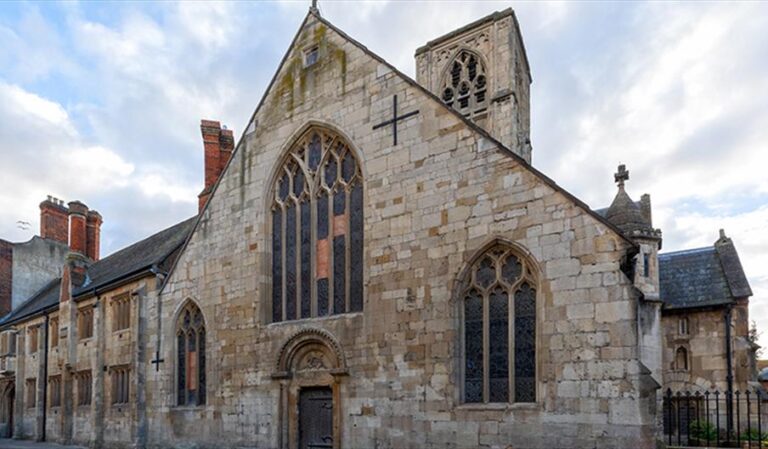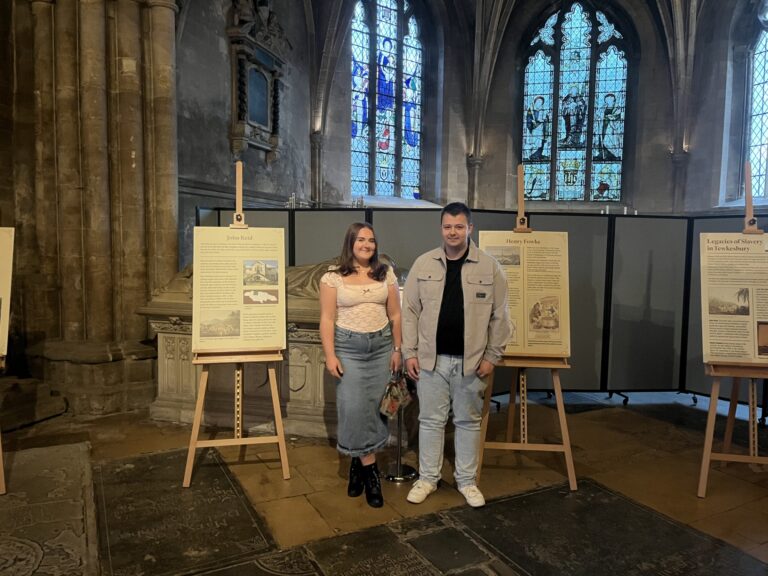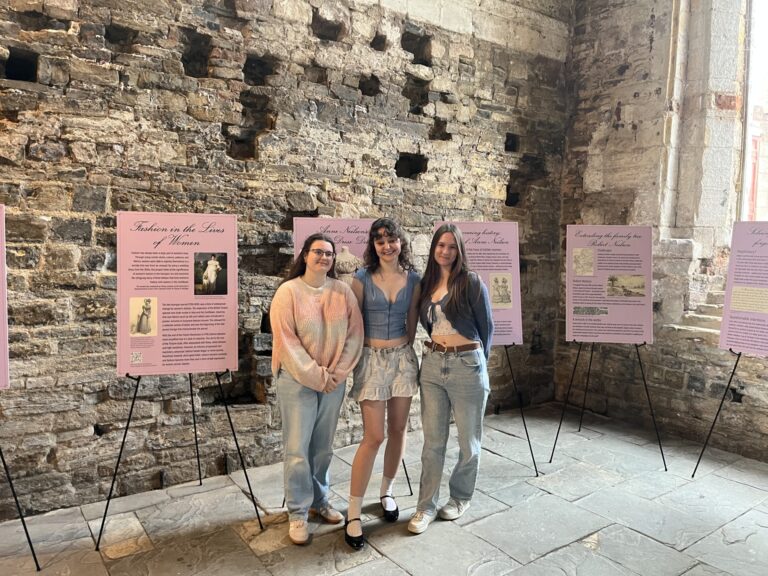| CC4HH
A hidden profile of Pittville
This project was conducted by Rachael Chandler, Katherine Sparks, Matthew Bedford and Hannah Treveil, in collaboration with Pittville History Works.
The following panels were exhibited at Chapel Arts in Cheltenham in September 2019 as part of the Gloucester History Festival 2019.
Jump to: Criminality to Bravery | The hidden side of Pittville | Cyril William Johnson – Villain to Hero | Pittville soldiers
Pittville: Criminality to Bravery
Brief History
Pittville was created by land developer Joseph Pitt, who wished to create a seasonal hotspot of around 100 acres attracting both holiday goers as well as the wealthy.
He hoped that wealthy families would move to the 500 to 600 grand houses he intended to build. The first medicinal well was dug in 1822 with the foundations for the Pump Room being laid in May 1825.
All works were entrusted to architect John Forbes. Building lots were first offered for sale in September 1824 and most sold straight away. Financial decline meant that many of these purchases were not completed and certain aspects of the planned development never took fruition, such as the church. Fewer houses were built, resulting in the Pittville we see today.
Medicinal waters were first discovered in Pittville in 1716 and Cheltenham gradually became a popular resort for the gentry. Throughout the eighteenth and nineteenth centuries there was a changing dynamic in Pittville brought about by national economic growth combined with population expansion: Cheltenham’s population rose from 3,076 in 1801 to 13,388 in 1821.
Pittville Pump Room was originally constructed in 1830 as the crown jewel of the estate. During the Second World War, the building was requisitioned by the government and was given to the US military for use as a supply depot. The US authority refused to allow inspections, and by the end of the war there was fungi and dry rot running rampant in the support structure. In compensation for the damage, the US offered £442-far short of the £3000 estimated repair costs. Heated debate divided members of the council over the question of the structure being saved at all.
The hidden side of pittville
As a hub for the aristocratic elite and the wealthy, Pittville was a large-scale employer for domestic workers and traders in Cheltenham, the majority of whom lived in the Lower High Street. The gates connecting these two areas still exist today. The geographic divide had an impact on criminality in Pittville.
There was a prevalence of petty crime between the servants and workers and their masters, as criminals attempted to take advantage of the wealth that existed in Pittville, or simply attempted to make ends meet. Some of those convicted of these petty crimes in Pittville can be seen below.

ALfred morgan
Convicted on 19 April 1870, aged 39, for larceny (stealing 9 knives), Alfred was a painter by trade assigned to one of the houses within Pittville. He was sentenced to 6 months hard labour.
Catherine Ann Mott
Catherine was convicted on 4 April 1870, aged 17, while she was in service as a charwomen (a cleaner) to one of the houses in Pittville, for stealing two and a half pounds of meat from her employer. She was sentenced to 2 months hard labour.


Thomas Pates
Thomas Pates was convicted, aged 44, of stealing a scythe and a billhook while in service as a gardener in one of the big Pittville estates. He was sentenced on 21 May 1870 to 1 month hard labour.
ELizabeth Crowder
Arrested at the young age of 14, Elizabeth Crowder was a servant in one of the Pittville houses. She was sentenced on 14 May 1870 to 7 day’s hard labour after stealing a purse and embroidery from her mistress.


FRancis Deal
Francis Deal was a sawyer employed by one of the houses in Pittville. He was committed on 7 May 1870, aged 34, to 6 weeks hard labour after stealing saws from his house of employment.
Elizabeth hill
Convicted on 2 July 1870 of stealing bed linen during her time as a charwomen (a cleaner) to one of the houses in Pittville, Elizabeth was sentenced to 6 months hard labour and 2 years supervision.

Newspaper Headlines
Criminality did not consist solely of petty acts. Pittville was also the location of major crimes as indicated in newspaper reports.
Bodies in Pittville lake
Pittville Lake has been the resting place of several bodies found under suspicious circumstances.
In January 1870, a young child’s body was found: John Malcock was found floating in the lake, leading to an inquest in August 1848, which ruled that he had been murdered. No one was ever convicted for the murder.
The petty crime of a rich man
Some assume that petty crimes were committed only by the lower classes, but in the mid 1800’s a wealthy Pittville home owner was charged with stealing wood from a ‘dead fence’ in Pittville
Petty crimes of stealing from Pittville Park were also reported in the newspapers: two girls were charged with stealing after picking flowers from a Pittville lawn.
The Murder of Emily Gardner
In 1871, Frederick Jones, aged 21 was charged and convicted of murdering Emily Gardner, aged 18. In a crime of passion, Jones killed his girlfriend while they were walking to No. 2 Bexham Villages, near Pittville Spa, where Emily worked as a servant. After a heated dispute turned physical, Jones caused ‘several wounds across the bridge of her nose and the jugular vein, and the wind pipe was completely severed’. Nothing was known of the crime until Jones returned home ‘covered in blood with a severe wound to his cheek. He said, “I’ve cut Emily’s throat.”
A police search located Emily’s body behind Wellington Square. When he was taken into custody, Jones stated, “she began it and I ended it.” Jones was charged and appeared in the dock of his trial with his face bandaged after attempting to take his own life. He was convicted of murder and was later hung at Gloucester Gallows.
Thomas Llewelyn
Thomas Llewelyn was charged with the murder of William Webb after eyewitness Sarah Wentley heard screams of ‘murder’. On entering the property, she found Webb conscious on the floor stating that Llewelyn had ‘broken my jaw’. Llewelyn, who was present at the time, stated that “I’ve not done with him yet”. As a result of this altercation, Webb died and Llewelyn was charged with murder.
The coroner considered ‘Firstly, whether they thought the death of the deceased was the result of the injuries received by him, secondly, whether these injuries were occasioned by accident or self-affliction, or whether they were afflicted by some person’. Llewelyn was committed to trial at the Gloucester Assizes.
William Leslie Whiting
In January 1927, aged 16, William Leslie Whiting was arrested and confessed to indecent exposure after exposing himself to a girl who was smoking in Pittville Park. Following his arrest, it was discovered that earlier in the day he had stabbed Joan Richards during a burglary. He stole ‘three rings, two gold lockets, two gold chains, one broach, one bracelet and one gold pencil case’. On acquiring these items he attempted to hide tine loot in Pittville Park, but was seen by Joan Richards.
Attempting to silence her, he stabbed her. He confessed, stating “Yes, I done it, and I’ve hid the stuff in Pittville Park. I’ll show you where it is. Some of the money I’ve hid in the lavatory at home”. In an attempt to reduce his sentence he was escorted to Pittville Park by the police, where he dug up the stolen items, which were then returned to their owner. He was refused bail and charged with burglary, the initial charge for indecent exposure was dropped.
Cyril william Johnson – from villain to hero
One of 360 servicemen listed on Cheltenham’s war memorial, Cyril William Johnson was a water transport driver who died at sea aged 29 during the Second World War, probably while taking supplies to Italy. Despite his heroic remembrance, Johnson spent much of his life as an unsatisfactory character involved in petty crime and he associated with habitual criminals. He was described as causing trouble for his parents and was sent to prison on at least three occasions.
1914: Cyril William Johnson born in Hitchin, Hertfordshire.
1921: aged 16. sentenced to 1 month imprisonment for stealing from schoolboy’s bicycles. His father left him to the magistrates, saying he could do nothing with him.
27 June 1930: sent to Canada in the car of the Salvation Army aboard the Duchess of York. By Christmas 1930, he had returned to England.
“The boy had had every chance’; ‘He has been out to Canada, but was idle and would not work”.
Dundee Evening Telegraph, 12 Nov 1931
1932: Johnson moved to Grosvenor Street, Cheltenham.
1935: in Tewkesbury, sentenced to 14 days hard labour for theft from a house.
12 September 1936: taken into custody for breaking into a lock-up at the Hotel Majestic (pictured below), where he stole a car with two others as a party for his birthday the next day.

“Well, it’s my birthday tomorrow. I should like to have a party”.
Glos. Echo 17 Sept 1936
17 September 1936: Johnson’s fingerprints were matched to a robbery at Cleveland House. Evesham Road Cheltenham earlier in the same day as a car theft.
22 October 1936: sentenced to 3 years in Borstal for the robbery and car theft. In his testimony, it was discovered that the three had driven to London where they disposed of the stolen property, which, ironically, included nine war medals.
2 March 1944: Cyril William Johnson died at sea in the Second World War. He has no known grave, and is commemorated on a missing person’s memorial.
With thanks from David Drinkwater.
Would you consider Cyril William Johnson a hero or a villain?
Is right that he is commemorated despite his criminal history?
Pittville Soldiers
Pittville soldiers and their addresses within Cheltenham.
Lieutenant Cyril Palmer
5 Clarence Square, Cheltenham Killed in action in Holland, 19 September 1944

Flying Officer William Bird
7 Evesham Road, Cheltenham Accidentally killed in Canada, 21 February 1941

Flying Officer (Air Bomber) Robert Edward Baker
92 Evesham Road, Cheltenham Killed in action in Germany, 9 October 1943

Gunner Wilfred Alfred Richard Whiting
48a, Prestbury Road, Cheltenham Killed in England by enemy action 1 November 1940

Pilot Officer Jack Wallace Garton
Prestbury Road, Cheltenham, Killed in action in England 9 July 1940

Flight Sergeant Denis Evan Fox
139 Prestbury Road, Cheltenham, Accidentally killed in England 8 November 1946

Sergeant Peter Louis Gregory
5 Pittville Lawn, Cheltenham Died of illness in England 3 November 1940

Major Leslie Roy Thomas Strathdum
Pittville Circus Road, Cheltenham, Killed in action 4October 1944

Sergeant (Pilot) Edgar Grenville Shaw
Laurel Lodge, Wellington Square, Cheltenham Accidentally killed, 12 March 1942

Flying Officer (Air Bomber) Donald Cameron McIntosh
Camden Lodge, Clarence Road, Cheltenham, Killed in action in Germany 30 November 1944

Matron Eileen Elise Stuartlevers
4 Clarence Square, Cheltenham, Killed in action at sea off the Maldive Islands, 12 February 1944
Volunteer (Home Guard) Thomas McCowat
17 Clarence Square, Cheltenham, Killed in action in France, 27 May 1940
Major Leslie Charles Dudley Ryder
19 Clarence Square, Cheltenham, Killed in action in France, 27 May 1940



